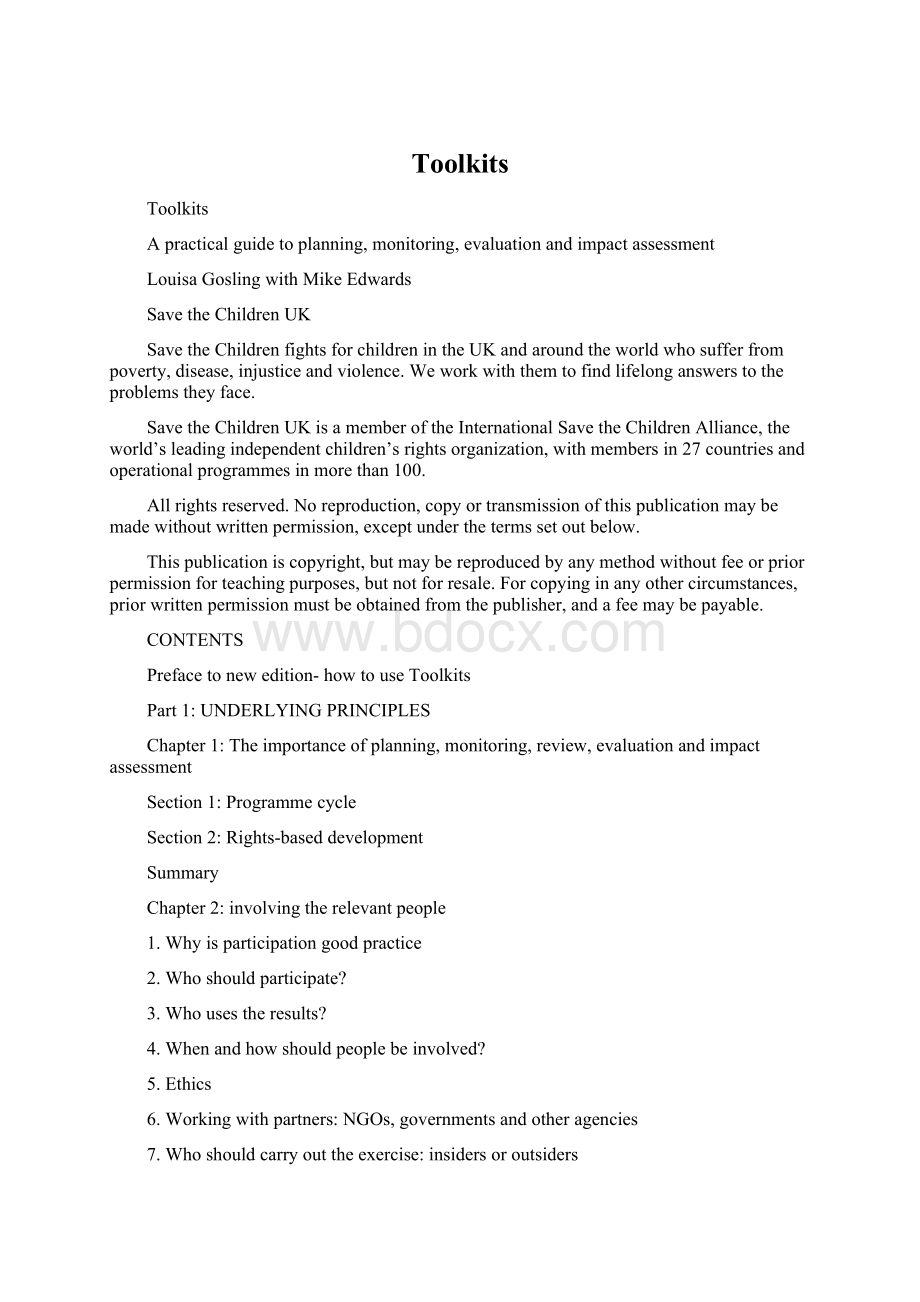Toolkits文档格式.docx
《Toolkits文档格式.docx》由会员分享,可在线阅读,更多相关《Toolkits文档格式.docx(14页珍藏版)》请在冰豆网上搜索。

Rights-baseddevelopment
Summary
Chapter2:
involvingtherelevantpeople
1.Whyisparticipationgoodpractice
2.Whoshouldparticipate?
3.Whousestheresults?
4.Whenandhowshouldpeoplebeinvolved?
5.Ethics
6.Workingwithpartners:
NGOs,governmentsandotheragencies
7.Whoshouldcarryouttheexercise:
insidersoroutsiders
Chapter3:
Recognizinganddealingwithdifferencesanddiscrimination
Recognizingdifferences,avoidingdiscrimination
Avoidingdiscrimination
Chapter4:
thesystematiccollectionandanalysisofinformation
Theprinciplesofbeingsystematic
Quantitativeandqualitativemethods
Whentousedifferentmethods
Part2:
PRACTICALQUESTIONS
Chapter5:
questionstoconsiderwhenundertakingplanning,monitoring,review,evaluationorimpactassessment
Termsofreference
1.Aimoftheexercise
2.Whoisitforandhowwilltheyusetheresults?
3.Objectivesandkeyquestionsoftheexercise
4.Informationcollectionanalysis
5.Presentingtheresultsandusingthefindings
6.Organisation
Chapter6:
Assessmentandprogrammeplanning
Designinganassessmentandplanningexercise
Thestageofassessmentandprogrammeplanning
Stage1:
problemidentification
Stage2:
carryingoutasituationanalysis
Stage3:
programmedesign:
howtoaddresstheproblemidentified
Stage4:
programmeappraisal
Stage5:
approvalandbaselinestudies
Chapter7:
monitoring
Typesofmonitoring
Designingamonitoringsystem
1.Definingtheaimofthemonitoringsystem
2.Theselectionofrelevantinformation
3.Thecollectionandanalysisofdata
4.Presentingandusingtheresults
5.Organisation
Chapter8:
Reviewandevaluation
Theroleofreviewandevaluation,andthedifferencesbetweenthem
Importantquestionstoconsiderwhencarryingoutareviewofevaluation
1.Thepurposeandaim
2.Whoisitforandhowwilltheyusetheresults
3.Objectivesandkeyquestions
4.Informationcollectionandanalysis
5.Presentingtheresults
Chapter9:
impactassessment
1.Whatisimpactassessmentandhowdoesitrelatetoplanning,monitoring,reviewandevaluation
2.Carryingoutastudythatfocusesonimpact
3.Clarifyingtheobjectivesandkeyquestionsoftheexercise
5.Carryingoutarevieworevaluationthatfocusesonimpact:
methodsandorganisation
Chapter10:
planning,monitoring,reviewandevaluationinemergencysituations
Introduction
1.Constraintsandcompromises
2.Specificaimandobjectives
3.Keyquestionsandindicatorsrelevantinemergencies
4.Methodsforcollectingandanalysinginformation
5.Presentingfindings
Chapter11:
Planning,monitoringandevaluatingadvocacy
1.Whatisadvocacy?
2.Settingadvocacyaimsandobjectives
3.Decidingwhattomonitorandevaluate
4.Howcanadvocacybemonitoredandevaluated?
Part3:
TOOLS
Tool1:
participatorylearningandaction(PLA)
Tool2:
Surveys
Tool3:
Logicalframeworkanalysis(LFA)
Tool4:
Cost-effectivenessanalysis
Tool5:
Strengths,weaknesses,opportunitiesandconstraints(SWOC)analysis
Tool6:
Settingobjectives
Tool7:
Exampleofevaluatingparticipation
Tool8:
usingconsultants
Tool9:
programmeorprojectvisit
Tool10:
presentingandsharinginformation:
meetings,diagrams,videoandtheatre
Tool11:
traininganddevelopmentinplanning,monitoring,review,evaluationandimpactassessment
Tool12:
stakeholderanalysis
Tool13:
frameworkstohelpanalysetheadvocacyprocess
Tool14:
frameworksfordevelopingmonitoringandevaluationquestionsinemergency
Referencesandfurtherreading
Evaluationandimpactassessment:
corereading
Methodsofinformationcollectionandanalysis
Advocacy
Emergencies
Evaluation
Disabilityandevaluation
Monitoringandevaluationontheinternet
Glossary
Acknowledgements
ThiseditionofToolkitshasbeenbasedoncontributions,commentsandadvicefromalargenumberofpeoplefromSavethechildrenUKprogrammesthroughouttheworld,andfromoutsidetheorganisation.Allofthesecontributionshavebeeninvaluableinguidingboththecontentandstyleofthebook.MembersoftheLearningandImpactAssessmentNetworkofSavetheChildrenUKhaveplayedacrucialroleinidentifyingnewissuestobeincorporated,contributingtothecontentandcommentingonthenewchapters.Individualsthroughouttheorganisation–toonumeroustoname–havecontributedideas,experienceandindividualcasestudies.ManypeoplefromdifferentsectionsoftheLondonofficehavealsoputagreatdealoftimeandeffortintoreadingandcommentingonvariousdraftsofthedifferenttoolsandchaptersofthebook.ThewholeprocesshasbeendiligentlyguidedandmanagedbyMartaForestiwithsupportfromSimonStarling,CarrieStebbings,andjohnWilkinsonfromtheLearningandImpactAssessmentteaminLondon.Anymistakes,inaccuraciesortractsofpoorwritingareentirelytheresponsibilityoftheauthor.
Prefacetothenewedition
AfterconsultationwithpeoplewhouseToolkits,itwaddecidedthataneweditionshouldincorporatethefollowingchanges:
∙Greaterrecognitionoftheroleofplanning,monitoring,reviewandevaluationforlearning,bothintheshortandlongterm,andforensuringgoodpractice,andimprovingbothpolicyandpractice.
∙Moreemphasisonassessingthewiderimpactofworkandconsideringtheshort-termandlong-termimplicationsofinterventions;
alsomoreemphasisonattribution(iftherehasbeenachange,howdoyouknowwhatcausesit?
)(SeethenewChapter9onimpactassessment.)
∙Moreemphasisonadvocacyandonhowitcanbemonitoredandevaluated(SeeChapter11andTool13.)
∙Ashiftfrom“needs-based”towards“rights-based”approachestodevelopment.SavetheChildrenisachildren’srightsorganisation,andthereforeadoptsarights-basedapproachtoprogramming.Thisneweditionaimstoshowhowthekeyprinciplesofchildren’srightscanbeappliedtoexistingapproachestoplanning,monitoring,reviewandevaluation.(SeeChapter1forfurtherdiscussionofrights-basedprogramming.)
∙Moreexperienceofusingparticipatoryapproaches,andinparticularpromotingtheparticipationofchildren.
Experienceshowsthatchildren’sview,notonlyforchild-focusedagencies.Therearenewcasestudiesthroughoutthebooktoillustratehowchildrencanparticipate.(Seealsochapters2and3andTool1.)
∙Moreemphasisonworkwithpartners.Thismeansadoptingamoreinclusiveapproachtoplanning,monitoring,reviewandevaluation.Newcasestudieshavebeenincludedtoillustratethis.
∙ThedevelopmentofSPHEREminimumstandardsforhumanitarianemergencyprogrammes.
HowtousToolkits
Toolkitsshouldbeusedasyouwouldareal“toolkit”,byselectingtheparticulartools(inthiscase,approachesortechniques)thatyouneedtodealwithaspecificproblem.
Developmentworkrarelyconformsinpracticetotheidealmodelsfoundinthetextbooks.Thesameistrueforthetechniquesandapproachesdescribedhere.Whenappliedinpractice,theyalwayshavetobeadaptedtolocalcircumstances.Thecasestudiesillustratesomewaysinwhichthishasbeendone.
Monitoringandevaluationtoolsarenotnewandmanyofthemaresimplywaysofusingcommonsensesystematically.Theyaredesignedtoassistinthewholestrategicplanningprocessbyprovidingsomeofthemeanstomakedecisionsinchangingcircumstancesinasystematicway.
StructureofToolkits
ThisbookhasthreeParts:
Part1shouldbereadfirstwhenundertakinganyplanning,monitoring,review,evaluationorimpactassessment.Itlooksatgeneralissuesthatarerelevanttoalltheseexercises.
∙Whyplanning,monitoring,review,evaluationandimpactassessmentareessentialtodevelopmentworkandhowtheylinktoplanninganddecision-making(Chapter1)
TheremainingchaptersinthisPartexaminethebasicconsiderationsthatneedtobeappliedthroughoutassessment,monitoring,reviewandevaluationifthefindingsaretobeusefulandrelevant.Theseunderlyingprinciplesare:
∙Involvetherelevantpeople(Chapter2).
▪Whoshouldparticipateinplanning,monitoring,review,evaluationandimpactassessment?
Whousestheresults?
▪Feedbackofthefindingstothoseinvolvedinthework.
▪Confidentiality
▪Workingwithpartners:
NGOs,governmentsandotheragencies.
▪Whoshouldcarryouttheexercise:
programmestafforoutsiders?
▪Differentapproaches:
participatory,non-participatoryandjoint.
∙Recogniseanddealwithdiff